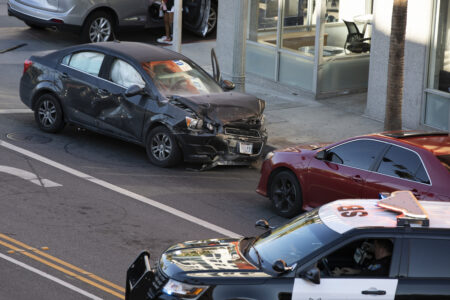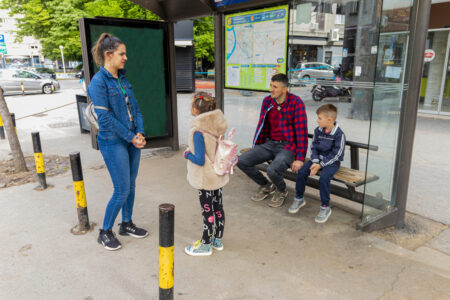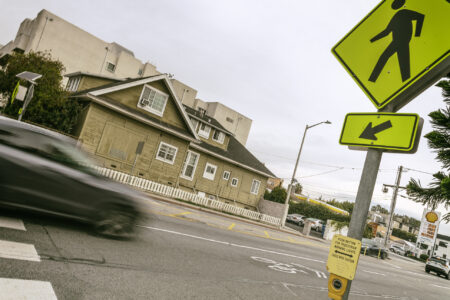Share On Social!
What we engineer and build impacts public health, safety, and welfare.
However, transportation engineering prioritizes convenience for people driving over safety for people walking or biking. This makes streets more dangerous for everyone, including drivers.
Now is our opportunity to change all that.
Public comments are wanted on revisions to one of transportation engineering’s “bibles,” the 700-page Manual on Uniform Traffic Control Devices for Streets and Highways (MUTCD).
The MUTCD, which was last rewritten 50 years ago from the point of view of expediting vehicle movement, is full of assumptions, restrictions, and contradictions that hinder efforts to improve safety and create vibrant, welcoming streets.
Submit one of three Salud America! model comments to tell the Federal Highway Administration (FHWA) to adopt a public health approach to reframe and rewrite the MUTCD by May 14, 2021.
The three model comments were created by our team in partnership with Dr. David Ederer, a; Steve Yaffe owner/president of Yaffe Mobility Consulting LLC; Flora Castillo, CHIE, president of Pivot Strategies, LLC, and the Honorable T. Bella Dinh-Zarr, PhD, MPH, Former Vice Chairman of the National Transportation Safety Board. We incorporated existing guidance from America Walks, the National Association of City Transportation Officials (NACTO), and Kostelec Planning.
Feel free to submit these comments as is, personalize them, or craft your own unique comment.
1. Tell FHWA to Overhaul the MUTCD with Public Health Approach to Safety
Dear Secretary Buttigieg and Acting Administrator Pollack,
Like disease, traffic injuries and deaths are preventable.
Thus, a public health approach is applicable to transportation engineering.
A public health approach adopts three levels of prevention strategies: primary, secondary, and tertiary. Primary prevention strategies emphasize systemic change to improve outcomes for entire populations by preventing risk factors and increasing protective factors, such as prioritizing narrow, connected streets and improving multi-modal level of service. Secondary prevention strategies detect risk factors and target interventions to prevent the extent and severity of negative outcomes, such as detecting excessive pedestrian delay and installing a pedestrian signal without mandating unrealistic pedestrian volumes in unsafe intersections. Tertiary prevention strategies manage negative outcomes after they have occurred, such as identifying pedestrian crash hot spots and targeting safety measures in those areas. The goal of primary and secondary prevention efforts is to prevent injury and death from ever occurring. This philosophy is at the center of the Safe System Approach in transportation safety.
While I recognize the time and effort that has gone into the current MUTCD revisions, the line-by-line revisions are not adequate to address the safety and accessibility concerns in our country.
After all, America is No. 42 of 51 high-income countries for per capita traffic fatalities.
The National Safety Council reports that during the past pandemic year, miles driven dropped 13% while the roadway death rate spiked 24% (https://salud.to/3g4zKTS). In addition, while the share of walking trips remained steady around 10.5% from 2009 and 2017, the number of people walking struck and killed by people driving increased 45% from 2010 and 2019, according to the new 2020 Dangerous by Design report from Smart Growth America (https://salud.to/dangerousplaces).
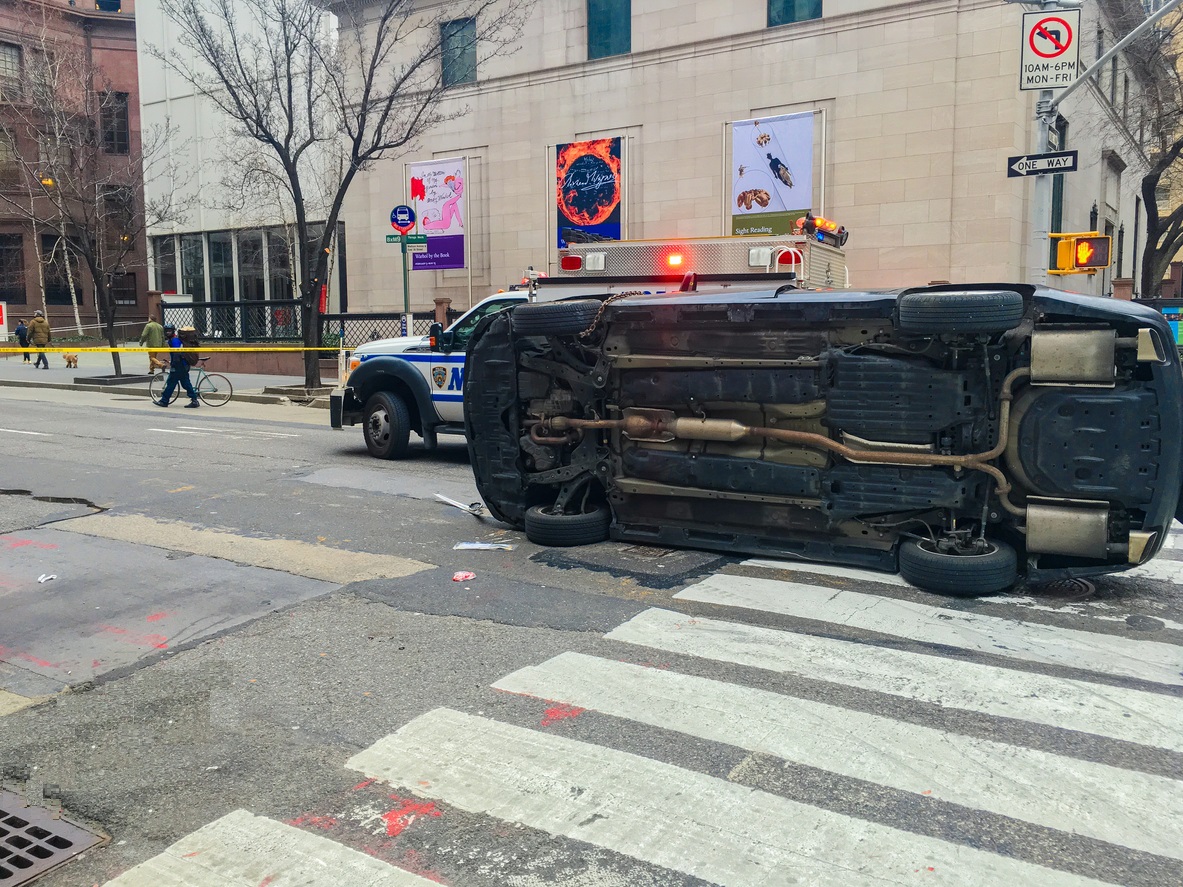
These deaths are neither random nor evenly distributed. “The fatality rate in the lowest income neighborhoods was nearly twice that of middle-income census tracts (in median household income) and almost three times that of higher-income neighborhoods,” the Dangerous by Design press release states.
Many deaths can be prevented if we overhaul the MUTCD with a public health approach to safety. The MUTCD can prevent injury and death by requiring signs and signals that prioritize people walking rather than requiring pedestrian delay, pedestrian conflicts, and pedestrians crossing a major street as criteria to justify signs and signals.
“Reduction or elimination of the risks faced by pedestrians is an important and achievable policy goal,” according to a 2013 road safety manual to save pedestrian lives from the World Health Organization (WHO).
As with public health efforts, the Safe System Approach is proactive and emphasizes prevention. The focus is on systemic change to create a built environment where simple mistakes do not result in serious injuries or deaths. For example, the primary cause of serious injuries and deaths on roads is the transfer of kinetic energy in a crash. We now know that efforts to increase free-flowing vehicles are a risk factor for injury. The Safe System Approach seeks to analyze and subsequently reduce risk factors and improve protective factors to minimize crashes and their consequences for entire populations. By adopting a Safe System Approach to safety, one can design high-risk conflicts out of the system.
While a larger effort to overhaul the MUTCD is merited, I understand there is an immediate need for some of the proposed revisions. Thus, it might be advantageous to develop a more responsive revision process that allows for periodic revisions between comprehensive decennial updates. The medical sector, for example, accepts and reviews annual requests for revisions to one of their most important documents, the International Classification of Diseases, Tenth Revision, Clinical Modification (ICD-10-CM). Revisions from the public and private sector are sent to the ICD-10-CM Coordination and Maintenance Committee for review before also going through the formal public comment period through the Federal Register. As travel behaviors change and new innovations and technologies emerge, engineering signs and signals need to adapt in this dynamic field.
As it is, the proposed revisions continue to stand in the way of the basic safety measures that are necessary to adopt primary, secondary, and tertiary prevention strategies to save lives.
In the face of unacceptable traffic injuries and fatalities and barriers to safe options, we need a MUTCD rule book that is informed by a public health approach to reduce risk factors and increase protective factors for the thousands of preventable deaths and millions of preventable injuries that occur on American roads every year.
2. Tell FHWA National Safety Experts Discourage Use of the 85th Percentile Rule
Dear Secretary Buttigieg and Acting Administrator Pollack,
I am concerned that the MUTCD revisions continue to rely on the 85th percentile speed.
By setting speed limits based on the fastest drivers at free flow conditions, the 85th percentile rule rewards people driving at excessive speeds and ignores the presence of people walking and biking. This generates a cycle of speed escalation at the expense of safety, particularly in cities.
Note that, in 2017, the National Transportation Safety Board (NTSB) discouraged use of the 85th percentile practice to set speed limits. Among the NTSB’s 2021-2022 Most Wanted Listed of Transportation Safety Improvements is the call for regulators to “revise regulations to strengthen requirements for all speed engineering studies and remove the guidance that speed limits in speed zones be within 5 mph of the 85th percentile speed” (https://salud.to/3shbOim).
“A growing body of evidence shows that speed limit changes alone can lead to measurable declines in speeds and crashes, even absent enforcement or engineering changes,” according to a July 2020 press release from NACTO. (https://salud.to/3uEL4dp)
 Federal guidance must be rooted in valid research that equates speed setting practices to the speed with the lowest crash involvement rate.
Federal guidance must be rooted in valid research that equates speed setting practices to the speed with the lowest crash involvement rate.
NACTO’s City Limits offers three solutions to the 85th percentile rule for setting speed limits on urban streets: setting default speed limits on many streets at once; designating slow zones in sensitive areas; and setting corridor speed limits on high priority major streets using a “Safe Speed Study.” (https://salud.to/39Zh3gk)
We need a MUTCD rule book that prioritizes practices to set speed limits based on safety for all road users, rather than based on how fast someone can comfortably drive.
Although my concern with the 85th percentile rule is just one example, I think it is reflective of the long-standing culture of transportation engineering that has privileged convenience for people driving over health, safety, and welfare for all people. I have additional concerns with the proposed revisions, too:
- Outdated signal warrant requirements that mandate unrealistic and unsafe pedestrian crossings perpetuate unwelcoming and unsafe roads for non-motorized road users.
- Including a new section for autonomous vehicles before including a section for pedestrians continues to prioritize vehicles over people.
- The omission of street lights as a traffic control device ignores the needs of non-motorized road users and exacerbates historic inequities in safe infrastructure in minority and low-income communities.
The proposed revisions continue to stand in the way of the basic safety measures that are necessary to create healthy communities and prevent injuries and deaths.
I join numerous individuals and organizations in asking that FHWA reframe and rewrite the MUTCD to create a path for guidance that more closely aligns with the numerous health, safety, equity, and sustainability goals of American cities. To achieve this goal, I also ask that FHWA ensures public health partners are included in the process. Of course, we also need an infrastructure bill to invest in retrofitting roads to create healthy communities.
3. Tell FHWA to Prioritize Vulnerable Road Users
Dear Secretary Buttigieg and Acting Administrator Pollack,
It is not only the unreasonable and imprudent who suffer in a traffic crash. We all know someone innocent that has been injured or killed in a crash.
Yet, according to the Manual on Uniform Traffic Control Devices for Streets and Highways (MUTCD), “The purpose of traffic control devices, as well as the principles for their use, is to promote highway safety and efficiency by providing for the orderly movement of all reasonable and prudent road users.”
Assuming that all road users share the virtue of prudence is severely deficient and gives engineers permission to ignore the needs of users who aren’t “reasonable and prudent.”
The US ranks No. 42 of 51 high-income countries for per capita traffic fatalities, and last year, 2020, had the highest year-over-year spike in the roadway fatality rate in 96 years (https://salud.to/3g4zKTS). This is not because Americans are inherently more reckless than individuals in other high-income countries. It is because our transportation system prioritizes the free-flowing movement of vehicles over the safety of everyone. It isn’t surprising then, that Americans view speeding as less dangerous than other risky driving behaviors, such as red-light running or tailgating, despite that even relatively small increases in absolute speed (5 and 10 mph) increase a driver’s risk of injury and death (https://salud.to/3uO0QCR).
One contradiction regarding assumptions of prudent behavior in the MUTCD is the utilization of the 85th percentile speed to set speed limits and simultaneous requirement for unrealistic volume of unsafe pedestrians crossing to warrant a traffic signal. These standards increase the speed limit because enough drivers engage in the risky behavior of speeding and simultaneously withhold safety measures for the most vulnerable road users because not enough pedestrians engage in the risky behavior of crossing a major street.
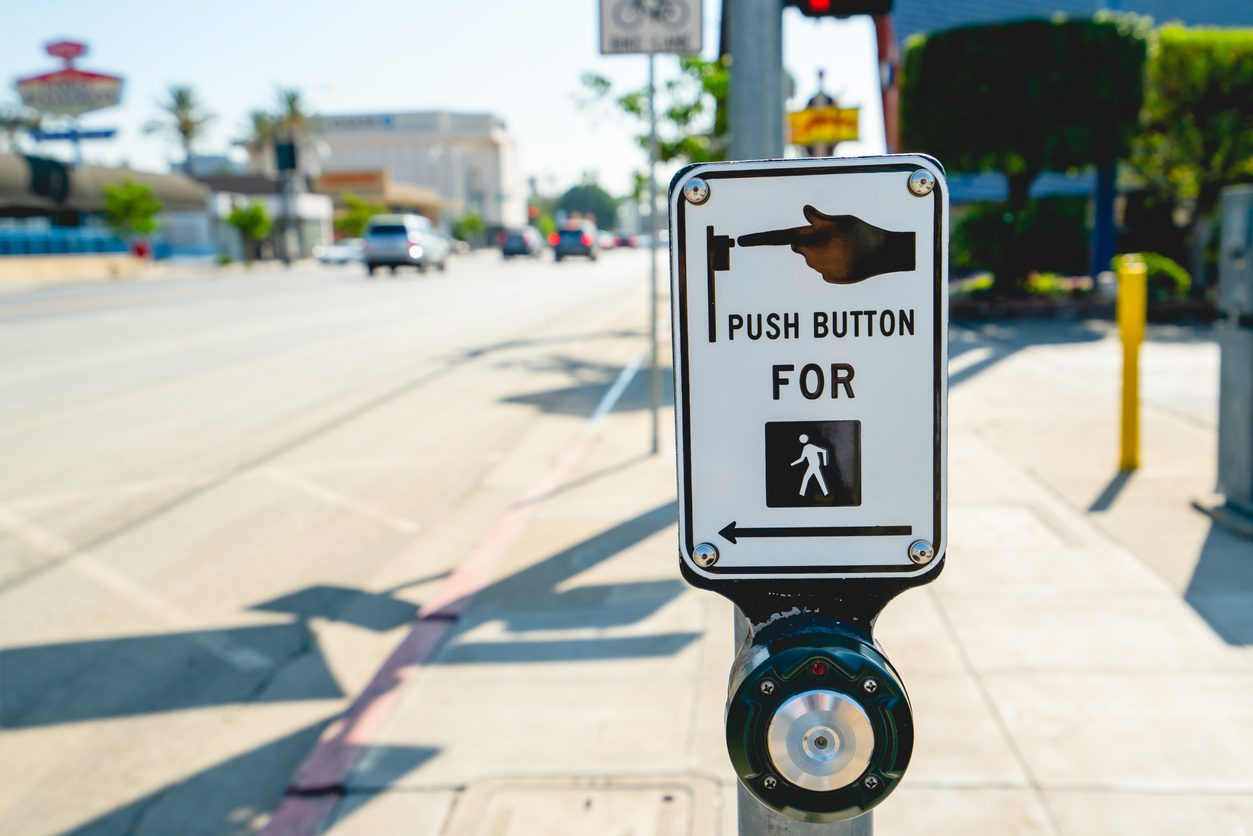 The signs, signals, and markings in the MUTCD dictate how our transportation system is constructed and for whom it is built. It shouldn’t be based on whether enough people speed or not enough people risk their lives crossing a major street.
The signs, signals, and markings in the MUTCD dictate how our transportation system is constructed and for whom it is built. It shouldn’t be based on whether enough people speed or not enough people risk their lives crossing a major street.
Instead of focusing on the behavior of prudent road users, the MUTCD should adopt the Safe Systems approach, which stipulates that mistakes should not result in serious injury or death on the roadway. The virtue of prudence should not be the baseline for engineering guidance. Meeting the needs of vulnerable road users should be the baseline for engineering guidance.
We need a MUTCD rule book that prioritizes vulnerable road users.
We also need a more responsive revision process so that allows for periodic revisions between comprehensive updates so that we don’t have to wait so long for new practices that could save lives. As travel behaviors change and new innovations and technologies emerge, engineering signs and signals need to adapt in this dynamic field. The medical sector, for example, accepts and reviews annual requests for revisions to one of their most important documents, the International Classification of Diseases, Tenth Revision, Clinical Modification (ICD-10-CM). Revisions from the public and private sector are sent to the ICD-10-CM Coordination and Maintenance Committee for review before also going through the formal public comment period through the Federal Register. I think reasonable and prudent transportation professionals could adopt a similar process rather than the current decennial process.
Why Your Comments Are Important to the Public Health of Our Nation
In 1931, the American Journal of Public Health and the Nation’s Health recognized “public health engineering as an essential calling.” Public health engineers focused on systemic preventive measures and protecting health across industry, government, and academia in the 1930s.
In 1946, CDC’s first governmental director was a civil engineer.
Yet today public health and transportation engineering are disconnected.
“Traditional transportation design has focused on designing streets and roadways for speeds that are generally inappropriate, especially in an urban context, contributing to unnecessary loss of life and serious injuries,” said Billy Hattaway, Transportation Director, City of Orlando, according to a July 2020 NACTO press release. “Practitioners need guidance on reducing posted speeds and managing speed to improve safety for all users, especially vulnerable users such as pedestrians and bicyclists.
Streets are increasingly dangerous for drivers and pedestrians, as the Manual on Uniform Traffic Control Devices for Streets and Highways (MUTCD) prioritizes the convenience of people driving over the health, safety, and welfare of all people.
Watch this four-minute video from Kostelec Planning to learn more about how outdated practices in this technical document, like traffic signal warrants, hinder basic safety measures, like crosswalk signals, for people to safely access food.
These put people’s lives are at stake.
That is why your public comment in this federal rule-making process is so important.
The public comment period is an avenue to share your personal experiences and/or professional expertise with decision-makers.
These federal agencies are required to consider your comments before making final decisions on them.
This is your chance to speak up for public health, safety, and welfare and make a difference.
“Disproven and unsafe practices remain in place, despite significant research and evidence on alternatives,” according to a public comment on the MUTCD revision from NACTO on behalf of 79 transportation and transit agencies.
Submit a comment by May 14, 2021.
Submit Comment 1!
Submit Comment 2!
Submit Comment 3!
Explore More:
Transportation & MobilityBy The Numbers
27
percent
of Latinos rely on public transit (compared to 14% of whites).

